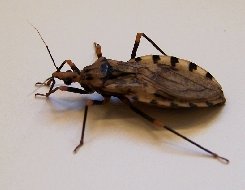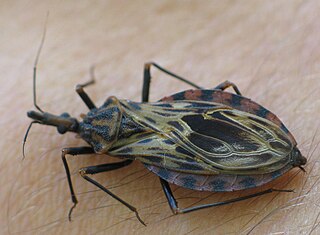
The Reduviidae is a large cosmopolitan family of the order Hemiptera. Among the Hemiptera and together with the Nabidae almost all species are terrestrial ambush predators; most other predatory Hemiptera are aquatic. The main examples of nonpredatory Reduviidae are some blood-sucking ectoparasites in the subfamily Triatominae. Though spectacular exceptions are known, most members of the family are fairly easily recognizable; they have a relatively narrow neck, sturdy build, and a formidable curved proboscis. Large specimens should be handled with caution, if at all, because they sometimes defend themselves with a very painful stab from the proboscis.

The members of the Triatominae, a subfamily of the Reduviidae, are also known as conenose bugs, kissing bugs, or vampire bugs. Other local names for them used in the Americas include barbeiros, vinchucas, pitos, chipos and chinches. Most of the 130 or more species of this subfamily feed on vertebrate blood; a very few species feed on invertebrates. They are mainly found and widespread in the Americas, with a few species present in Asia and Africa. These bugs usually share shelter with nesting vertebrates, from which they suck blood. In areas where Chagas disease occurs, all triatomine species are potential vectors of the Chagas disease parasite Trypanosoma cruzi, but only those species that are well adapted to living with humans are considered important vectors. Also, proteins released from their bites have been known to induce anaphylaxis in sensitive and sensitized individuals.

Triatoma is a genus of assassin bug in the subfamily Triatominae. The members of Triatoma are blood-sucking insects that can transmit serious diseases, such as Chagas disease. Their saliva may also trigger allergic reactions in sensitive individuals, up to and including severe anaphylactic shock.

Mepraia is a genus in the subfamily Triatominae, endemic in Chile, and vectors of Chagas disease.
Microtriatoma is a genus of bugs that belongs to the subfamily Triatominae.
Parabelminus is a genus of bugs in the subfamily Triatominae. The species of this genus could be found in Brazil, specially in Rio de Janeiro and Bahia. It is a vector of Chagas disease.

Panstrogylus geniculatus is a blood-sucking sylvatic insect noted as a putative vector of minor importance in the transmission of Trypanosoma cruzi to humans; this is a parasite, which causes Chagas disease. The insect is described as sylvatic; subsisting primarily in humid forests, and is also known to inhabit vertebrate nesting places such as those of the armadillo, and is also involved in enzootic transmission of T. cruzi to those species. It has wide distribution throughout 16 Latin American countries.

Triatoma nigromaculata is a sylvatic species of insect usually found in hollow trees, in vertebrate nests on trees and occasionally in human dwellings. It usually lives in relatively humid forests at high altitudes on mountain regions and foot hills. As all members of the subfamily Triatominae, T. nigromaculata is a blood-sucking bug and a potential vector of Chagas disease. This species is distributed mainly in Venezuela, but some specimens have also been found in Perú and Colombia (Cauca).

Leopoldinia piassaba, the Para piassava, piassava fiber palm or piassava palm, is a palm native to black water rivers in Amazonian Brazil and Venezuela, from which is extracted piassava, a high caliber and water resistant fiber. Piassaba fiber is made into brooms, baskets and other products. This plant is also a natural habitat of the Rhodnius brethesi which is a potential vector of Chagas disease and it is cited in Flora Brasiliensis by Carl Friedrich Philipp von Martius.

Triatoma brasiliensis is now considered the most important Chagas disease vector in the semiarid areas of northeastern Brazil. T. brasiliensis occurs in 12 Brazilian states, including Maranhão, Piauí, Ceará, Rio Grande do Norte, and Paraíba.
Triatoma juazeirensis is an assassin bug, a Chagas disease vector which occurs in the State of Bahia, Brazil. It is found in natural and artificial environments infesting mainly the peridomiciliary areas but it may also colonize the intradomicile. T. juazeirensis can be distinguished from the other members of the brasiliensis complex by its entire dark pronotum and legs.
Triatoma platensis is a species of assassin bug in the family Reduviidae. It is found in South America.

Triatoma gerstaeckeri is an assassin bug in the genus Triatoma. It is an important vector of Trypanosoma cruzi, the causative agent of Chagas disease. The range of T. gerstaeckeri is from the south-western United States to north-eastern Mexico. T. gerstaeckeri goes through three stages during its paurometabolous life cycle: egg, nymphal instars and adult.

Triatoma lecticularia is a species of kissing bug in the family Reduviidae. It is found in Central America and North America.
Triatoma rubida is a species of kissing bug in the family Reduviidae. It is found in Central America and North America.
Triatoma neotomae is a species of kissing bug in the family Reduviidae. It is found in Central America and North America.

Linshcosteus is a genus of assassin bugs in the subfamily Triatominae. It is the only genus of Triatomines restricted to the Old World within the mostly Neotropical subfamily Triatominae and consists of six species restricted to peninsular India. Within the Triatominae, the genus is differentiated by the lack of a prosternal stridulatory furrow and a short rostrum that does not reach the prosternum. Adults feed on vertebrate blood.

Panstrongylus megistus is a blood-drinking insect in the subfamily Triatominae. It is found in the Guianas, Brazil, Bolivia, Paraguay, Uruguay and Argentina. It is an important vector of Trypanosoma cruzi, found particularly in Brazil. Besides humans, P. megistus is known to feed on birds, rodents, horses, dogs, opossums and bats.

Triatoma sordida is an assassin bug within the genus Triatoma. This species consists of three subspecies. Also referred to as kissing bugs, T.sordida are most well known for their role as a secondary vector of Chagas Disease. Inhabiting warm, dry climates, T.sordida are widely distributed throughout South America, occupying houses, farming structures, and wild habitats. Pest control is currently focused on insecticide application. However, biological controls utilizing fungi appear promising.













